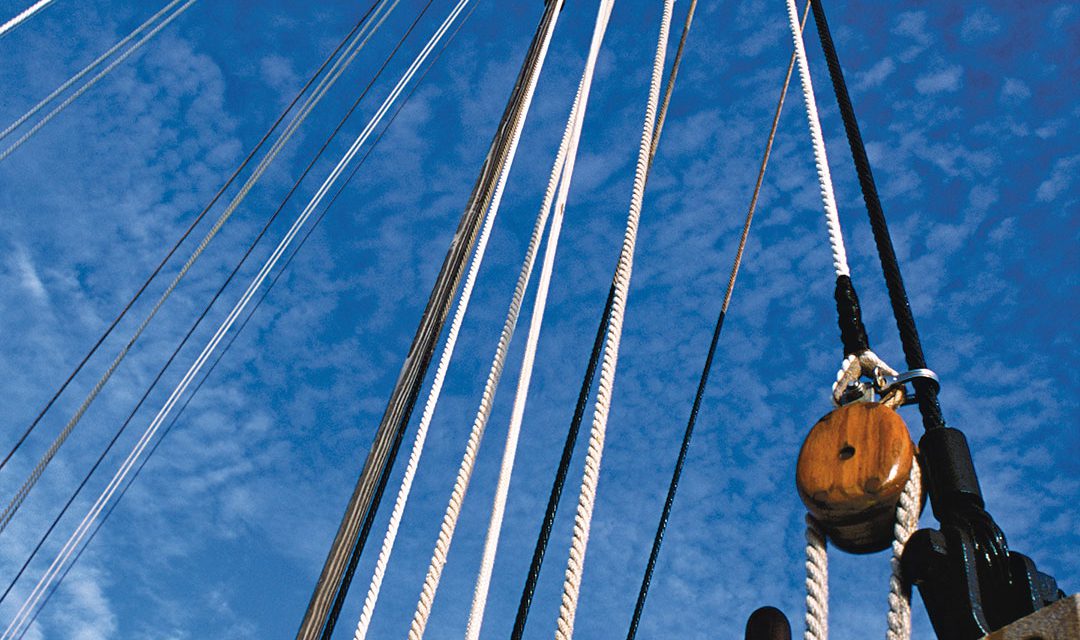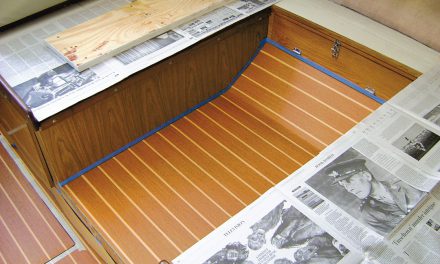Easily taken for granted, rope is a critical thread throughout human history.
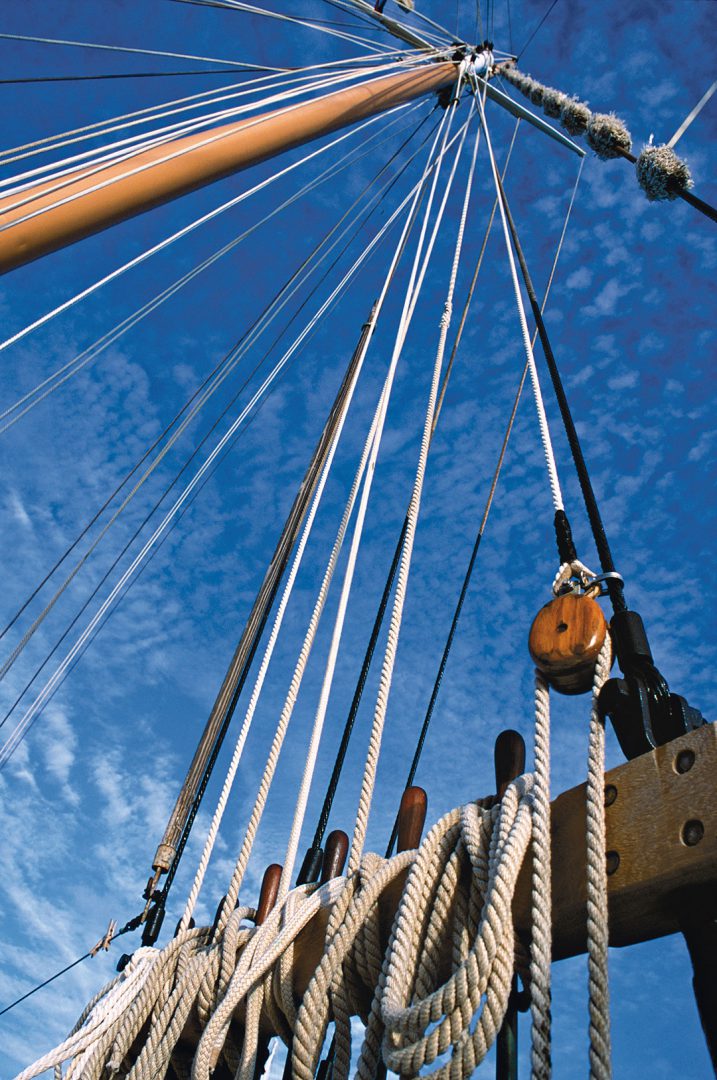
The traditional steel ketch Moya is fitted with three-strand rope befitting her gaff rig. Note the baggywrinkles, a good use of old rope.
Issue 135: Nov/Dec 2020
What do sailors, the Egyptian pyramids, Britain’s cotton mills, and the first space shuttle all have in common? They all depend on, or depended on, rope. Rope has been around for so long that we tend to take it for granted, yet it’s no exaggeration to say that it has been associated with almost every major development in human civilization.
Rope has been integral to creating buildings and bridges, to catching and taming animals, to creating weapons, and to farming, fishing, and sailing. Rope was even used for mathematical purposes by the Incas, and software written by MIT programmers was woven into a core rope memory system used in guidance computers aboard the Apollo spacecraft.
When a piece of string—woven no differently than the three-strand we use aboard sailboats today—was discovered in a French cave earlier this year and found to be 50,000 years old, it challenged long-held anthropological assumptions. Twisting and braiding natural materials to make longer, stronger lengths of rope requires more advanced cognitive abilities than we’d previously credited to the Neanderthal brain. And rope is probably even older than that. Evidence suggests the use of rope could predate the use of fire.
So, rope is important.
The basic method of making rope goes like something this: Spin the fiber into yarns by overlapping the lengths and twisting them together. Twist three or more sets of yarns together to form the strands. Twist three or more strands together to form the rope. At each stage, twist the line in the opposite direction from the previous stage—this is the key step in keeping rope from unraveling and turning into a pile of shredded wheat.
But consider that in the early sailing days, the standard unbroken length of rope was 120 fathoms, or 720 feet. Before modern machinery took over in the 1800s, rope was made using a ropewalk, a long, narrow, straight lane on which strands of material (originally this was hemp) could be laid out.
Workers spent their days walking backwards down the ropewalk, using their chapped fingers to spin by hand combed hemp fiber into yarn. It took many trips down the ropewalk before multiple strands of yard were twisted into rope and then the multiple ropes formed into cables sized for the job aboard a sailing ship. And demand was great; anything that sailed needed rope, and a single average ship would require more than 30 miles of rope aboard when she set sail.
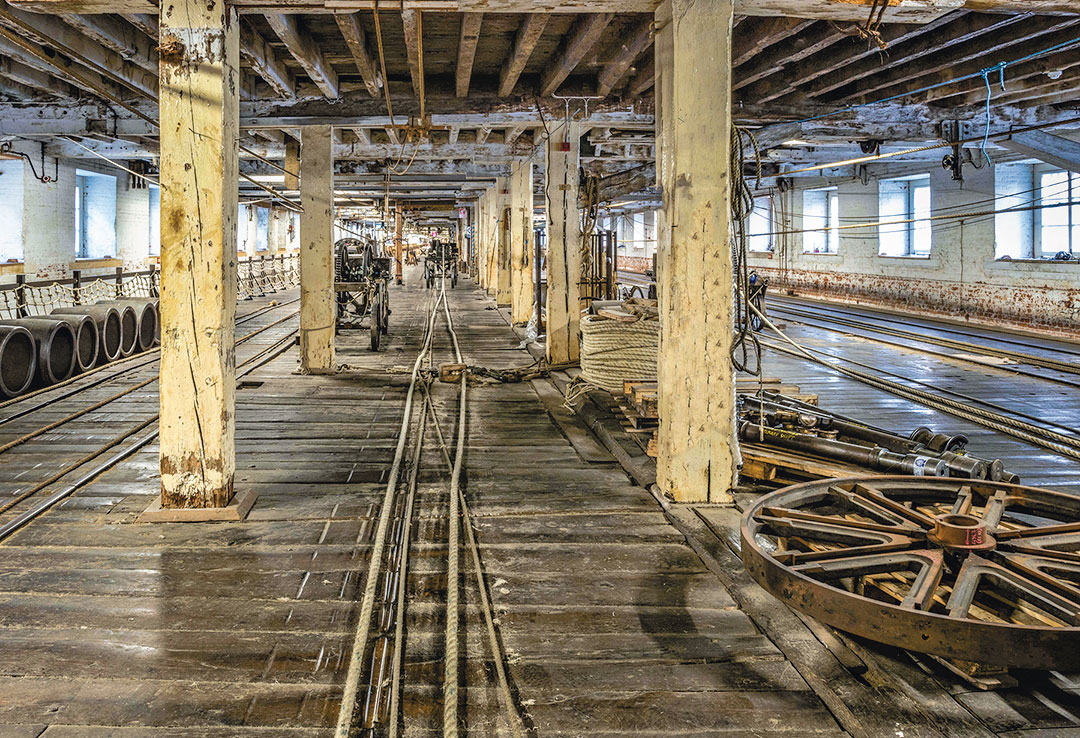
The Ropery at Chatham Dockyard in Kent has been producing rope for over 400 years on this ropewalk, including that used aboard Lord Nelson’s HMS Victory. Master ropemakers continue to produce custom rope at this singular example of 18th-century ropemaking technology.
Given rope’s imperative, it’s no coincidence that one of the early settlers to America was a ropemaker. John Harrison moved from Salisbury to Massachusetts in 1640 on the promise of having a monopoly of the rope trade for the duration of his life. He duly profited from the arrangement for 30 years, establishing two ropewalk factories in the process.
To meet the world’s growing appetite for rope, innovators created increasingly sophisticated ropewalks. Early mechanization of the process involved attaching three sets of yarn to three hooks on a “jack.” The hooks rotated to twist the yarn into strands. Once the strands were made, the ends were attached to a single hook on wheels (the carriage) at the other end of the ropewalk, which was in turn rotated in the opposite direction to twist the stands into rope. As the strands contracted, the carriage was rolled closer to the jack, with the finished rope being about two-thirds the length of the original strands.
Rope made of three strands was called plain- or hawser-laid; rope made of four strands was called shroud-laid, and rope made of three or more lengths of three- or four-strand rope was called cable-laid.
By the end of the 18th century, most seaside towns had ropewalks, especially those with a nautical tradition: Boston boasted 14 ropewalks in 1794, followed soon after by Plymouth, across the pond, which also had 14 by 1816. So important was rope for the Royal Navy that it built its own ropewalk at Chatham Docks in Kent. When it was completed in 1790, the 1,135-foot building was the longest brick building in Europe, and it remains the only traditional ropewalk producing rope commercially to this day.
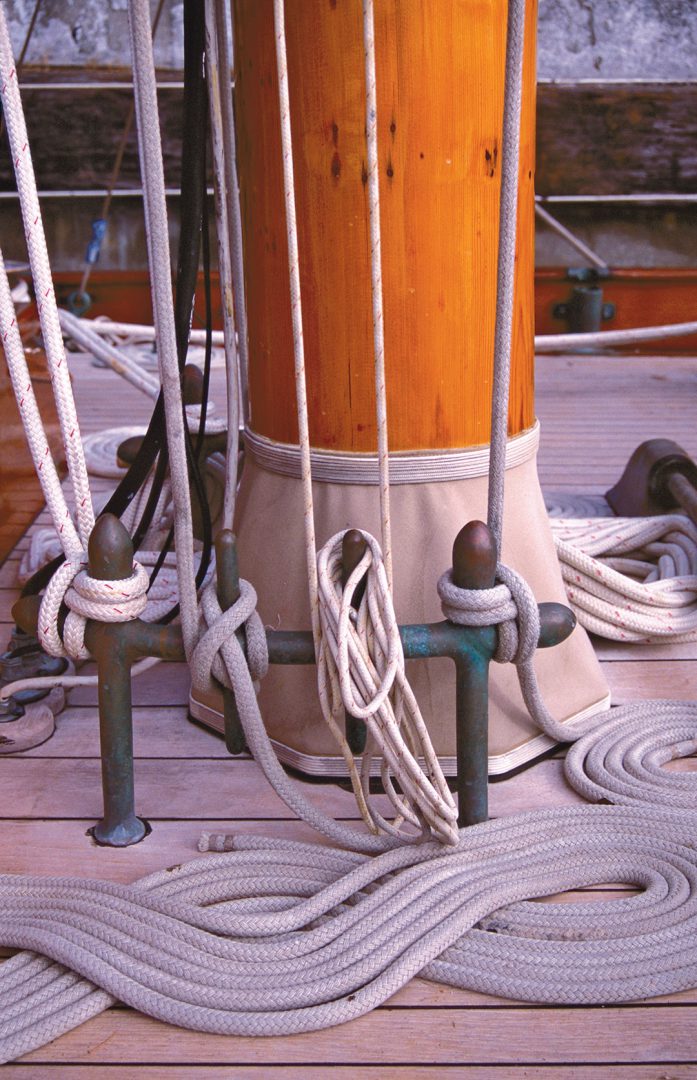
Neatly coiled ropes on the 85-foot William Fife yacht Astor, moored in Hobart, Australia. Braided rope is used for all the running rigging.
As the age of industrialization took hold, rope’s import did not wane. The massive cotton mills that gave Britain such a great commercial advantage might have been powered by steam, but that power was transmitted to each floor of the factory, and to each individual loom, by means of rope. Even when steam took over from sail and wire took over from rope towards the end of the 19th century, other markets for rope were soon found in the expanding farming and fishing industries.
A variety of materials was used to make rope at this time, but hemp (made from the cannabis plant) was favored from the 17th century. In the 19th century, hemp was superceded by manila (made from the abacá plant) and coir (made from coconut shells), as well as sisal, cotton, and jute.
Despite the increasingly sophisticated means of production and new materials, rope itself remained unchanged for hundreds or even thousands of years until the mid-1930s, when the American chemicals company, DuPont, spent millions of dollars trying to invent a substance that would replace silk—not for making rope or any such useful enterprise, but for making ladies’ stockings. They succeeded spectacularly, of course, and when the first nylon stockings appeared on the market in 1940, they sold out within hours. But America’s ladies would have to wait a little longer for their miracle hosiery, as from 1942 to 1945 most of DuPont’s nylon went towards the war effort, helping to make tires, parachutes, and glider leads. Thus, the world’s first nylon rope was born, and there would be no looking back.

The 136-foot Eleonora, a replica of the Westward, is that rare thing: a superyacht fitted at launch with galvanized standing rigging, for authenticity. The running rigging is a more pragmatic mix of three-strand and braided.
The advantages of nylon rope were overwhelming. It was about 20 percent stronger than natural fiber, more resistant to abrasion, and didn’t rot. Nylon lasted four to five to times longer and was much easier to handle. Nylon was more slippery than natural fibers, but that characteristic could be addressed by adding an extra hitch to a knot or a couple more tucks in a splice. Nylon rope also stretched more than natural-fiber rope, but for many uses this was an advantage. Nylon was soon the rope of choice for mooring lines and anchor rodes.
Nylon was quickly followed by polyester, invented by Imperial Chemical Industries in 1941, acquired by DuPont in 1946, and eventually marketed as Dacron. Although polyester wasn’t quite as strong as nylon, it didn’t stretch as much and didn’t suffer a loss in strength when submerged (nylon loses 15 percent of its strength when submerged). Polyester (Dacron) soon became the go-to material for rope used for halyards and sheets.
Polypropylene joined the fray in 1957. Cheap and unpleasant to handle, it floated, which made it useful in rescue and waterski lines.
By this time, mechanized rope-making methods were in full swing and braided rope (usually 8 or 12 stands braided together), which had been around for centuries but had long required extensive skilled manual labor to produce, became more common, especially in the form of nylon and polyester ropes.
Another big step came in 1957, when Samson Rope (established in 1878 as J.P. Tolman Company in Massachusetts) invented double-braid rope. Not only did double-braid feature a soft jacket woven over a strong core for easy handing, it was stronger than single-braid rope. It quickly found a home aboard sailboats the world over.

A young sailor enjoys getting a turk’s head made around her wrist during a sail aboard the 1895 Colin Archer rescue boat Christiania.
The next innovation came in the form of materials. Kevlar, Dyneema, and Spectra were all invented in the 1960s and ’70s and were soon put into service aboard high-end racing yachts, such as Australia II. In 1982, she splashed with Kevlar running rigging (and a carbon-fiber boom). NASA used the same lightweight ropes (also made by Samson) to operate the shuttle’s cargo bay doors aboard the first space shuttle in 1977. But NASA and America’s Cup teams could afford ropes made of high-modulus materials; decades passed before this technology was priced within reach of the average sailor.
The main disadvantage of these ropes (apart from cost) remains that they are difficult to tie because they are extremely slippery (the triple fisherman’s knot is the usual solution), and difficult to splice (the needle and thread made an unexpected comeback here). But the high strength-to-weight ratios of these ropes easily overcome these deficiencies, and Dyneema and Spectra are both widely used, even aboard classic yachts. It’s a less abrasive option than wire for certain applications, such as strops and even standing rigging. Not only that, but the strength of these high-modulus ropes has resulted in a return to soft fittings, such as shackles and rigging eyes.
Although rope made of natural fibers is now mainly used for decorative purposes, it can still be found in most households either in the form of Spot Cord—a cotton rope invented by Samson in 1884 and still finding a role making sash cords and clotheslines—or in that most common of strings, the shoelace, where the friction of natural fibers helps compensate for most people’s tendency to tie a granny knot instead of the much more secure reef knot.
From three-strand to braided, from hemp to Kevlar, rope has evolved in the 50,000 years since that French fragment was made, yet the basic principles remain the same. Consider this: The Neanderthals who made that recently uncovered rope could turn up today and, while much of what they would see might amaze and appall them, they would recognize a modern rope and understand what it was for. Humble, useful rope represents a continuous line to the past and, no doubt, to the future. Long may it remain unbroken.
Brought up on boats from birth, Nic Compton could tie a “fast bowline” and was making monkey’s fist keyrings by the time he was 12. Since then, he has written 18 books, mostly about boats and the sea, including The Knot Bible. A Knot a Day is coming in 2021.
Thank you to Sailrite Enterprises, Inc., for providing free access to back issues of Good Old Boat through intellectual property rights. Sailrite.com

